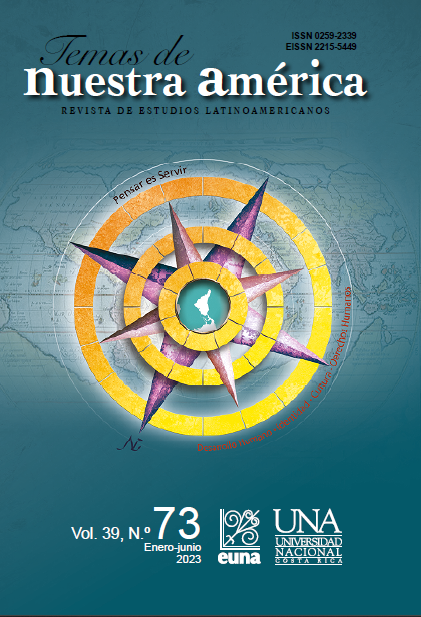Human rights and their protection in the inter-American and international arenas: The Lhaka Honhat case, Salta, Argentina
DOI:
https://doi.org/10.15359/tdna.39-73.8Keywords:
human rights, protection, inter-american, indigenous people, Lhaka HonhatAbstract
The purpose of this article is, on the one hand, to reflect and problematize the notion of human rights in Latin America. On the other hand, to describe and analyze the instruments and mechanisms of international and inter-American protection of human rights that promote tools for their respect and guarantees for all people. Finally, an attempt is made to analyze the Lhaka Honhat case, taking into account the institutional frameworks that the Inter-American System for the Protection of Human Rights employs in the face of the alleged violation of the right to property to the detriment of the indigenous communities of the town of Rivadavia, Province of Salta, Argentina.
The interest in addressing these objectives takes up the idea of thinking about the protection of human rights as normative responses to problems and needs that occur in society. In this way, theoretical tools are used to discuss the conceptions that revolve around how human rights are currently understood and, in what way, certain instruments, mechanisms and systems at the international and inter-American levels promote their protection regarding indigenous peoples. Consequently, it is assumed that human rights make up a field of social, historical and cultural struggles for dignity, understanding them as equal access to goods necessary for life, the results of which must be guaranteed through legal, political and economic norms.
References
Asúnsolo-Morales, C. (2015). Los derechos humanos como límites al poder público y privado: otra vía de fundamentación. Dixi, 17(22), 95-106.
Carrasco, M. & Zimmerman, S. (2006). Informe IWGIA: el caso Lhaka Honhat. Grupo internacional de trabajo sobre asuntos indígenas. Centro de Estudios Legales y Sociales.
Carrillo Salcedo, J. A. (2000). Derechos humanos y derecho internacional. Isegoría, (22), 69-81. https://doi.org/10.3989/isegoria.2000.i22.522
Comisión Interamericana de Derechos Humanos (s. f.). Derechos de los pueblos indígenas y tribales sobre sus tierras ancestrales y recursos naturales. http://cidh.org/countryrep/TierrasIndigenas2009/Cap.V-VI.htm
Comité de Derechos Económicos, Sociales y Culturales. (2018). Observaciones finales sobre el cuarto informe periódico de la Argentina. Consejo Económico y Social: Naciones Unidas.
Di Bernardi, F. (s. f. a). “Unidad 1: Consideraciones generales en relación a los derechos humanos”. Teoría de los Derechos Humanos II - Maestría Educación en Derechos Humanos: Centro de Cooperación Regional para la Educación de Adultos en América Latina y el Caribe (CREFAL).
Di Bernardi, F. (s. f. b). Unidad II: Introducción a la protección internacional de los derechos humanos. Teoría de los Derechos Humanos II - Maestría Educación en Derechos Humanos: Centro de Cooperación Regional para la Educación de Adultos en América Latina y el Caribe (CREFAL).
Di Bernardi, F. (s. f. c). “Unidad III: El Sistema Universal de Protección de los Derechos Humanos”. Teoría de los Derechos Humanos II - Maestría Educación en Derechos Humanos: Centro de Cooperación Regional para la Educación de Adultos en América Latina y el Caribe (CREFAL).
Di Bernardi, F. (s. f. d). “Unidad IV: El Sistema Interamericano de Protección de los Derechos Humanos”. Teoría de los Derechos Humanos II - Maestría Educación en Derechos Humanos: Centro de Cooperación Regional para la Educación de Adultos en América Latina y el Caribe (CREFAL).
Gialdino, R. (2004). La producción jurídica de los órganos de control internacional de los derechos humanos como fuente del derecho nacional. Fuentes universales y americanas. Anuario de Derecho Constitucional Latinoamericano (tomo II). Instituto de Investigaciones Jurídicas de la UNAM.
Herrera Flores, J. (2008). La reinvención de los derechos humanos. Atrapasueños.
Nicoletti, J. A. (2007). Derechos humanos en el mundo contemporáneo. Revista Iberoamericana de Educación, 42(3), 1-12. https://doi.org/10.35362/rie4232405
Nikken, P. (1993). El concepto de derechos humanos. En Estudios básicos de derechos humanos I. Instituto Interamericano de Derechos Humanos.
Salvioli, F. (2007) El Sistema Interamericano de Protección de los Derechos Humanos. XXXVIII Session d'Enseignement: Recueil des Cours, textes et sommaires/Collection of Lectures, Texts and Summaries. Estrasburgo: Institut International des Droits de l'Homme.
Savioli, F. (s. f.). Curso básico sobre el Sistema Universal de Protección de los Derechos Humanos de la Organización de las Naciones Unidas. https://www.minjus.gob.pe/wp-content/uploads/2017/09/1.2.pdf
Steiner, C., & Uribe, P. (2014). Convención Americana sobre Derechos Humanos. Fundación Konrad Adenauer.
Villán Duran, C. (2016). Manual sobre el Sistema Universal de Protección de los Derechos Humanos. Consejo de la Universidad para la Paz.
Downloads
Published
How to Cite
Issue
Section
License
Esta obra de Revista Temas de Nuestra América está bajo una Licencia Creative Commons Atribución-NoComercial-SinDerivar 4.0 Internacional.
Cualquier permiso que trascienda dicha licencia, debe solicitarse por escrito a la persona directora de la Revista










